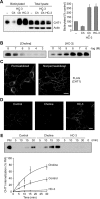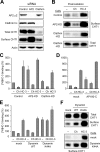Substrate-induced internalization of the high-affinity choline transporter
- PMID: 22016532
- PMCID: PMC6623556
- DOI: 10.1523/JNEUROSCI.2983-11.2011
Substrate-induced internalization of the high-affinity choline transporter
Abstract
Cholinergic neurons are endowed with a high-affinity choline uptake system for efficient synthesis of acetylcholine at the presynaptic terminals. The high-affinity choline transporter CHT1 is responsible for choline uptake, the rate-limiting step in acetylcholine synthesis. However, endogenous physiological factors that affect CHT1 expression or function and consequently regulate the acetylcholine synthesis rate are essentially unknown. Here we demonstrate that extracellular substrate decreases the cell-surface expression of CHT1 in rat brain synaptosomes, primary cultures from the basal forebrain, and mammalian cell lines transfected with CHT1. Extracellular choline rapidly decreases cell-surface CHT1 expression by accelerating its internalization, a process that is mediated by a dynamin-dependent endocytosis pathway in HEK293 cells. Specific inhibitor hemicholinium-3 decreases the constitutive internalization rate and thereby increases cell-surface CHT1 expression. We also demonstrate that the constitutive internalization of CHT1 depends on extracellular pH in cultured cells. Our results collectively suggest that the internalization of CHT1 is induced by extracellular substrate, providing a novel feedback mechanism for the regulation of acetylcholine synthesis at the cholinergic presynaptic terminals.
Figures






Similar articles
-
Competitive inhibition of the high-affinity choline transporter by tetrahydropyrimidine anthelmintics.Eur J Pharmacol. 2021 May 5;898:173986. doi: 10.1016/j.ejphar.2021.173986. Epub 2021 Feb 26. Eur J Pharmacol. 2021. PMID: 33640406
-
Ion coupling and inhibitory mechanisms of the human presynaptic high-affinity choline transporter CHT1.Structure. 2025 Feb 6;33(2):321-329.e5. doi: 10.1016/j.str.2024.11.009. Epub 2024 Dec 9. Structure. 2025. PMID: 39657660
-
The hemicholinium-3 sensitive high affinity choline transporter is internalized by clathrin-mediated endocytosis and is present in endosomes and synaptic vesicles.J Neurochem. 2003 Oct;87(1):136-46. doi: 10.1046/j.1471-4159.2003.01974.x. J Neurochem. 2003. PMID: 12969261
-
The "ins" and "outs" of the high-affinity choline transporter CHT1.J Neurochem. 2006 Apr;97(1):1-12. doi: 10.1111/j.1471-4159.2006.03695.x. Epub 2006 Mar 8. J Neurochem. 2006. PMID: 16524384 Review.
-
Molecular properties of the high-affinity choline transporter CHT1.J Biochem. 2014 Oct;156(4):181-94. doi: 10.1093/jb/mvu047. Epub 2014 Jul 29. J Biochem. 2014. PMID: 25073461 Review.
Cited by
-
Identification and characterization of ML352: a novel, noncompetitive inhibitor of the presynaptic choline transporter.ACS Chem Neurosci. 2015 Mar 18;6(3):417-27. doi: 10.1021/cn5001809. Epub 2015 Feb 2. ACS Chem Neurosci. 2015. PMID: 25560927 Free PMC article.
-
Nonoisotopic assay for the presynaptic choline transporter reveals capacity for allosteric modulation of choline uptake.ACS Chem Neurosci. 2012 Oct 17;3(10):767-81. doi: 10.1021/cn3000718. Epub 2012 Jul 9. ACS Chem Neurosci. 2012. PMID: 23077721 Free PMC article.
-
Methamidophos exposure during the early postnatal period of mice: immediate and late-emergent effects on the cholinergic and serotonergic systems and behavior.Toxicol Sci. 2013 Jul;134(1):125-39. doi: 10.1093/toxsci/kft095. Epub 2013 Apr 17. Toxicol Sci. 2013. PMID: 23596261 Free PMC article.
-
Understanding transporter specificity and the discrete appearance of channel-like gating domains in transporters.Front Pharmacol. 2014 Sep 12;5:207. doi: 10.3389/fphar.2014.00207. eCollection 2014. Front Pharmacol. 2014. PMID: 25309439 Free PMC article. Review.
-
Transmembrane topology and oligomeric structure of the high-affinity choline transporter.J Biol Chem. 2012 Dec 14;287(51):42826-34. doi: 10.1074/jbc.M112.405027. Epub 2012 Nov 6. J Biol Chem. 2012. PMID: 23132865 Free PMC article.
References
-
- Bernstein EM, Quick MW. Regulation of gamma-aminobutyric acid (GABA) transporters by extracellular GABA. J Biol Chem. 1999;274:889–895. - PubMed
-
- Chi L, Reith ME. Substrate-induced trafficking of the dopamine transporter in heterologously expressing cells and in rat striatal synaptosomal preparations. J Pharmacol Exp Ther. 2003;307:729–736. - PubMed
-
- Doherty GJ, McMahon HT. Mechanisms of endocytosis. Annu Rev Biochem. 2009;78:857–902. - PubMed
Publication types
MeSH terms
Substances
LinkOut - more resources
Full Text Sources
